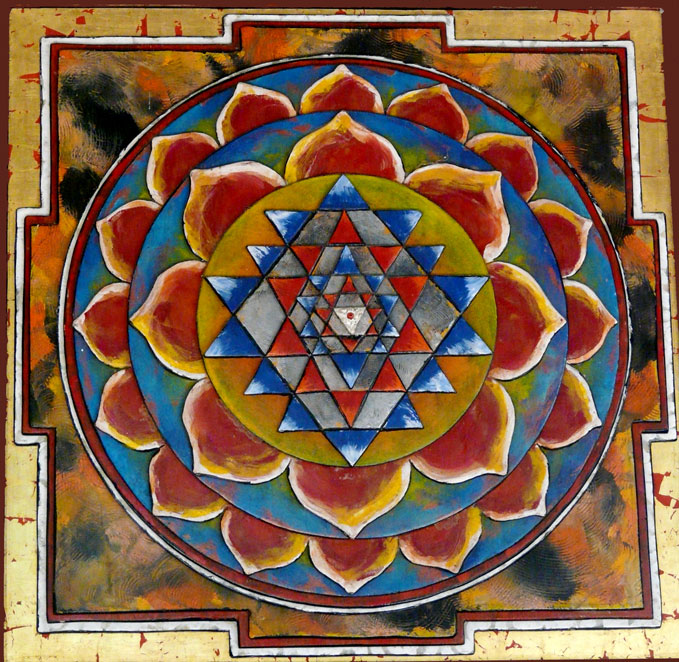
| Maha Meru* The Maha Meru, or Sri Meru Chakra, is a three-dimensional projection of the great yantra known as Sri Chakra, said to be the Mother of all Mandalas. The sublime geometry of the Sri Chakra is revealed wisdom. It is not of human origin. It is nothing less than the genetic code of the Cosmos. It is intelligent. As one commentator aptly explained, “Sri Chakra is the technology of the Absolute, skillfully fashioned in Divinity’s own self-image.” Every yantric shape emits a very specific frequency and energy pattern. Sri Chakra is said to contain within itself the essence of all other yantras, and thus it contains the essence of all traditions. Certain powers, for example, are ascribed to the six-pointed Star of David, the Christian cross, the five-pointed star, the Egyptian and Meso-American pyramids, and so on. The Meru’s particular configuration is revered in all Eastern traditions: It integrates the essence of Indian Mother Goddess worship, Mahayana Buddhism, Chinese feng shui, the Eleusinian mysteries of the Ancient Greeks, and so much more. The Maha Meru can bring unbounded happiness and every good thing in life. In its Maha Meru form, Sri Chakra radiates an aura of Love and Order, literally creating a sacred space around itself. Wherever it is placed, it brings order, peace, happiness, health, and wealth – in short, everything that is needed. Just keeping it in one’s home will confer great blessings, because the Meru subtly connects itself to the other major yantras in the world. Its mere presence is said to cleanse the home of defects under both the vaastu and feng shui systems; to ward off and neutralize negative energies and the “evil eye”; to protect against unfavorable planetary influences; and to bring about healing, prosperity and peace of mind. 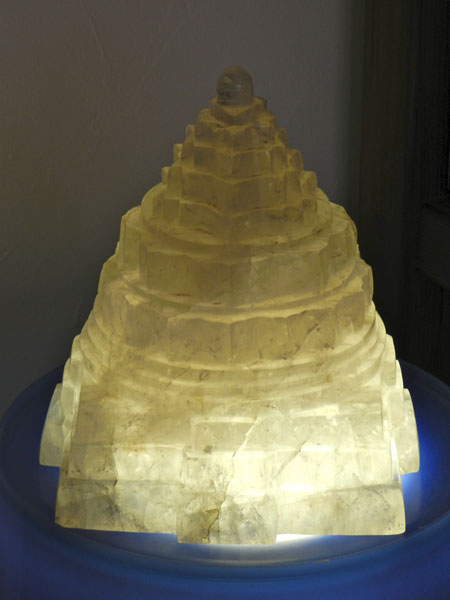 People of all beliefs, religions and sects may reap the benefits of peace, healing and prosperity by installing the Maha Meru in their homes, offices, shrines and places of worship, as well as in hospitals, healing centers, prayer halls and wedding centers. It may be given as a loving and auspicious gift for newlywed couples embarking on their lives together, for adult children setting out on their own, for friends and relatives moving into a new home or embarking on a new endeavor; even as a corporate gift from employers to valued employees – in each case, it will empower the recipient in every possible way. Q: Is Maha Meru primarily a Hindu Yantra? A: I would prefer to say that it’s a universal yantra, belonging to all religions – yantras resembling this one include the Sri Chakra of Hinduism, and the Mahayana Mandala of Buddhism. Chinese feng shui employs similar yantras. The Egyptian Pyramids are yet another form of this yantra; the Greek Eleusinian Mysteries involved still another. Q: What is the specifically Hindu interpretation of Maha Meru? A: It is worshiped as the source of the Cosmos and of all power. It creates and sustains the entire Cosmos, and we should therefore strive to understand, worship and realize this power and intelligence that runs the world. The Khadgamala yoginis [i.e. the goddesses that inhabit Sri Chakra] emanate like rays from Sri Lalita, the Maha-Devi [Great Goddess] at Sri Meru’s center. All gods worship Her power in order to share it and to do good; all demons worship Her power in order to loot and exploit. The Meru is one form of the power and beauty found in the principles of geometry and symmetry that govern the world. Aspects of Her immense powers are variously called Yoga-Maya, Durga, Kali, Vaishnavi, Chandika, Lakshmi, Saraswati, and so on; like the fruits of a wish-fulfilling tree. Various scriptures – such as the Shakti Upanishads, the Brahmanda Purana, the Sri Chakra Samhita, the Sri Chakra Yoga Sara, the Sri Chakrartha Sara and others – all state in a single voice that merely seeing the Sri Chakra washes away all sins and grants auspiciousness. A mere touch burns away sin like a wad of cotton wool consumed by a fire. Even if one does no puja, just keeping it in the home attracts all good to the home. And if one worships the Supreme Power in the Meru with devotion, there remains no desire unfulfilled; one experiences infinite enjoyment, both here and in the hereafter. People of all castes and religions, especially women, may – without the slightest doubt – keep it in their homes and worship it in any way they can. There is no siddhi that cannot be attained by regular worship of a faultless Meru. Q: Should the Maha Meru be kept in places other than the home or temple? A: It can be kept anywhere. If kept in the home, it will connect itself to all the other yantras in the world through its Bindu and attract organizing, peaceful and loving vibrations from wherever they are in the world. It is also a good thing to keep in hospitals, as it has healing properties. Or it can be kept in the office, because it attracts wealth, abundance and organization in the office. It is good to keep in public places too, because there will be an aura of grandeur and peace coming from this yantra. So it’s a universal symbol, which can be kept anywhere and everywhere. 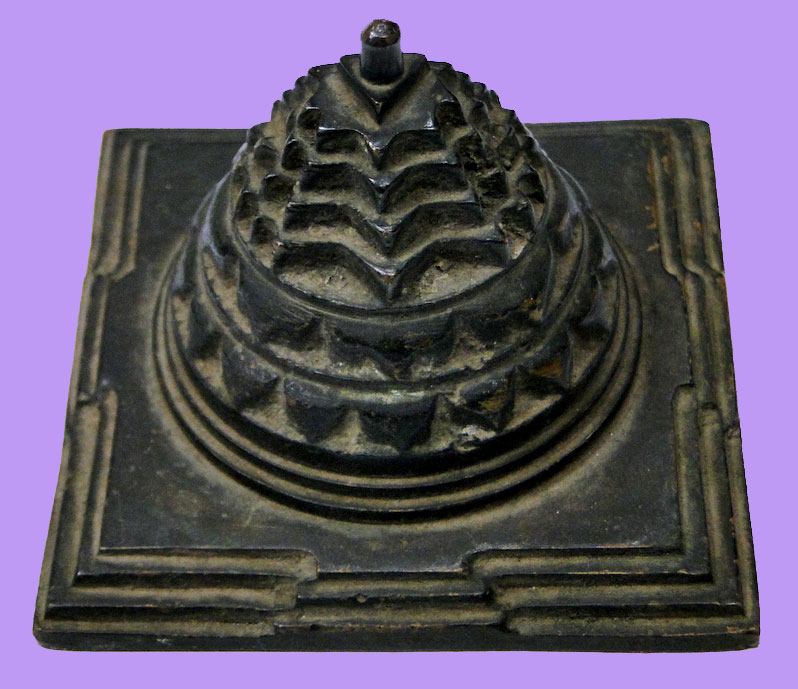 Q: Should we do puja to the Maha Meru? A: You can do puja if you wish to, but that does not imply that it needs puja. When the Maha Meru is already energized. Since it then connects itself with the all other yantras in the world, it continuously receives vibrations and powers from all over the world, including the cosmic centers of power. It receives abundance and grace, and redistributes them in its own vicinity. Thus, by itself, it does not need any puja as such. However, the nature of the vibrations it radiates can be enhanced very positively if you play soft music in the place where it is kept – similar to what we see in the entrance lobbies of hospitals and hotels, and so on, where soft music is played to bring about a peaceful attitude in the people who enter these places. So if you can do pooja to the Meru, well and good. If you can’t, you just play some soft music to it. It will absorb the vibrations and emit divine music that protects and heals, that wards off evil and brings prosperity. And not merely currency, but all forms of divine blessings of peace – love, truth, non-violence; principles that empower everyone. Q: Many people are fond of keeping a Maha Meru in their homes as a kind of protection for their families. Why is that? A: The Maha Meru represents the Cosmic Power as it manifests itself through human beings. Life itself is derived from this yantra, and when it is kept in the home it enhances the quality of life for all the people living there. Actually the temples made by human beings are constructed of rocks, cement, steel and things like that – whereas the temple that the Goddess has made, is simply the body of human beings, ourselves. In a sense, your body is itself a Sri Chakra, a yantra in which the Awareness, the Goddess, lives. If you can live in your body, if your awareness can live in your body, then why can’t it live in your home? Q: But what do you say to people who are afraid to bring a Meru into their home (or other environment)? After all, there are those pundits who say a Meru should never be kept in the home. A: These fears are mainly induced by certain members of the orthodox Brahmin community, who insist that the power should be kept with them only. We’ve got to get over this barrier of fear. We want to give, to share the power with everyone. So please not succumb to the misinformed, thoughtless statements being made by these so-called pundits, and thus miss the chance to obtain the power than can alter your destiny in every way. The Vedas say Matru Devo bhava: “There is no duty higher than worship of the Mother” – and the Mother is available to everyone as the Meru, Her highest form; other forms being icons or women empowered as the Goddess. So keep a Meru in your home; give it as a gift; think of it as a long-term investment – like having a good spouse! Don’t compromise on quality. Pay any price, because it is priceless. The Meru is a symbol of our power to overcome evil, and to create unlimited wealth, health and happiness. The Meru is Gayatri, who protects those who utter Her name; it is Savitri, who conceives all good karmas for Her worshipers. Q: Just to clarify, does this statement apply to everyone? Can the uninitiated also keep Sri Chakra Merus in their homes without incurring the wrath of the Goddess? A: Yes, absolutely. How can nectar become poison? It is not in its nature to harm. It is in its nature to bless. The hand that blesses does not strike. Whether we know it or not, whether we acknowledge it or not, Adi Para Shakti is already in our homes, in our bodies, in our minds, in our notions of I and mine, in our families, in all that we see – because She is the All-Pervading Awareness. We cannot lose Her without losing our life, because She is verily the life within us. Does the fact that we breathe require initiation? She has already initiated us into life as the Mother who gave us SRI, which means everything. She extracted the seed from our father, giving ecstasy to him; She assembled us from life-giving substances of Her own body, gave us our hormones and endocrine system, our bones, flesh, skin, blood and all; She made us atom by atom, molecule by molecule; and most importantly, She put Her awareness into us. 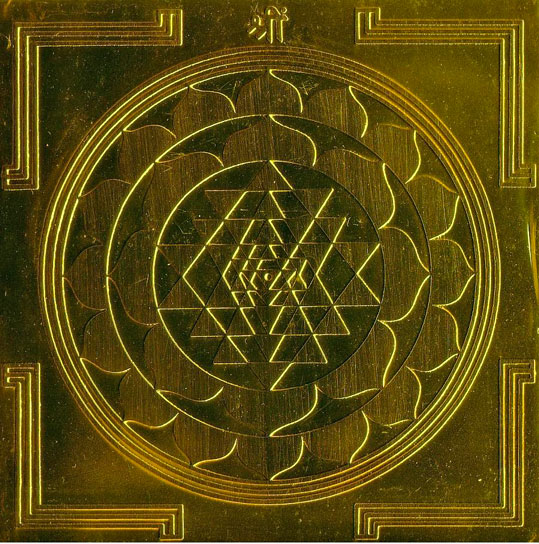 Again, the Sri Chakra Meru is but one of Her forms, the others being (2) our own physical bodies; (3) the psychic chakras in our subtle bodies, from Muladhara to Sahasrara, seven in number; (4) the world we live in; (5) Hamsa Gayatri, the breath of life which goes in and out as long as we live; and (6) Siva Linga, symbol of union of Shakti (the Yoni base) and Siva (the Linga characteristic of the Godhead). These forms are not different; they are all one and the same, they all represent Sivayor Vapuh. The moment any one of them is present, all others are present in them as well. The gifting of this Meru involves a gifting of Power. Q: Accurate in which way? A: Well, to get the sorts of benefits we’ve discussed, three conditions must be satisfied: (1) The Meru must be perfect, having 28 marmas as points, not as triangles (a marma is a joint of three straight lines); (2) it must be placed in the puja room, or else in a prominent, well-lighted place in the home with Vedic or mantric chants being played to it; or simply soft music. Light and sound are two higher forms of worship. Then the Meru will act like an antenna, first attracting the Supreme Power, and then retransmitting it all around your home, bringing good to all. Q: Why is the Maha Meru hollow? A: That’s a legitimate question. It was intentionally made hollow. But so many questions have been raised about the hollowness of the Sri Chakra! It has to be hollow! There is no other way! Why? It is hollow because it is supposed to represent a viyat chakra – a wheel in space. And by the way, even if you are determined to make it totally solid, even if you think you’ve made it totally solid, still it is ultimately composed of atoms and molecules. And atoms and molecules have nuclei at their centers, which are like the Sun in the solar system – the electrons and neutrons orbit through relatively vast spaces around the nucleus. Even if you go to the nucleus itself, it is still not solid; it consists of stage particles. In fact, the whole nucleus is very hollow and inside it there are only probability waves traveling through. Thus even the supposedly “solid” atoms and molecules that make up the manifest world consist mostly of empty space. So it is not true to say that the Meru has to be solid – because there is nothing that is solid. Somehow this concept requiring solidity does not really stand up in light of scientific views. 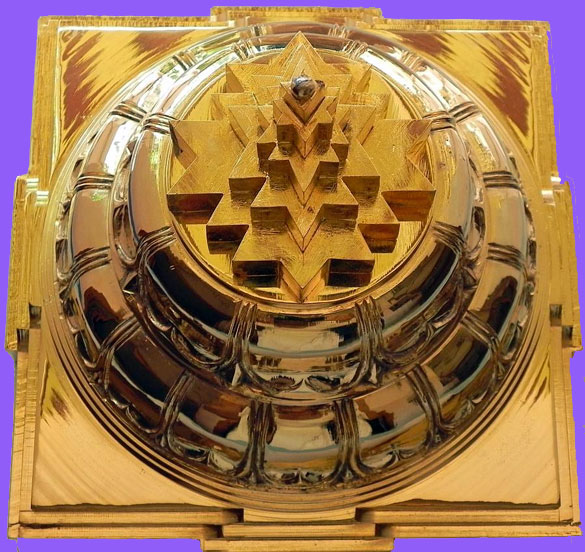 Q: This design is significantly different from that of a typical Meru. How so? A: This particular style of Meru was inspired by the design of the original that was unearthed in 1984. It is embellished with the symbols of the Chatura Ayatana (“Four Seats”) deities – Ganapathy at Nairuti (southwest), Vishnu at Vayu (northwest), Surya at Ishanya (northeast) and Shiva at Agni (southeast). These four symbols, taken together with the Bindu (Devi), represent the Shakti Pancha Ayatanam (“Five Seats of Shakti”). The Shakti Pancha Ayatanam are present right in the Meru itself, thus making it very unique. People doing Shakti Pancha Ayatana puja need not obtain each of the idols individually, as the Meru itself contains them all. Another unique feature is that the Meru has extra diamond-shaped plates above the star shapes having fourteen, ten, ten and eight corners. And on the other hand there was the accuracy – three lines joined without forming triangles – which was very good. This characteristic does qualify to make it a good Sri Chakra. It is unique in the sense that a lot of care has been taken to ensure that the yantra is accurate. That accuracy comes from the very definition of the yantra found in the texts that define Sri Chakra in Hinduism and Vajrayana Buddhism. We prefer bronze instead of panchaloha – where they say they put in some gold, but it usually doesn’t happen. It’s usually a brass thing coated with gold, and merely called panchaloha – we are avoiding that. When you use a zinc and tin mixture, which is brass, it oxidizes and reduces to the color of zinc, which is black. When a bronze Meru is left unattended and gets oxidized, it looks silvery. What happens with the inauthentic so-called panchaloha is that the outer gold layer eventually wears or washes off and becomes flat – that’s how you come to know that it is made out of brass. We avoid this problem by keeping it permanently as either gold or copper. For big temples and other places, we can go in for pure gold or gold and silver. The molds we’ve made allow us to manufacture to any specifications. 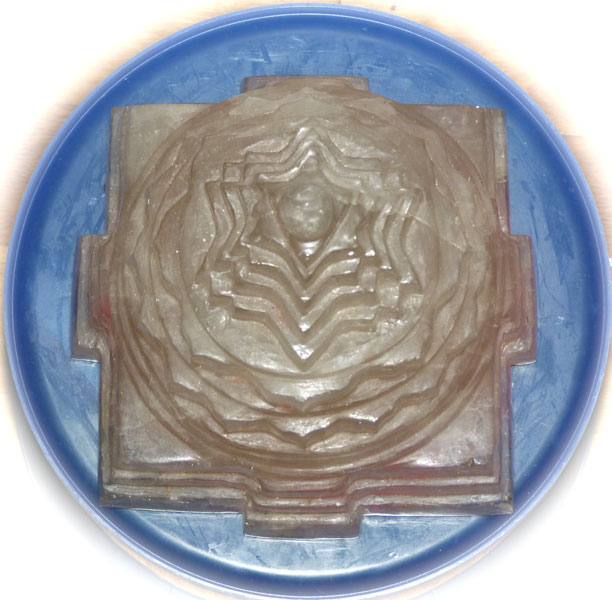 The Structure of Maha Meru The form ofMaha Meru is both beautiful and deeply significant; its every curve and line is charged with layer upon layer of wisdom and meaning. As a first step toward gradually fathoming these depths, why not take some time to examine the structure of your new Meru. You will note that it is comprised of nine avaranas (enclosures or divisions). Each of these successive avaranas has its own distinct shape, name and guardian deities. Each is raised in graded elevations, with those lower and closest to the outer edges being the Devi’s more tangible and concrete manifestations, and those higher and closer to the center becoming progressively more subtle and transcendent in nature: • The ground-level enclosure of Sri Chakra is known as the Bhupura; literally, the earthworks, as would surround an ancient walled city. It is visualized as a square chaturasra consisting of three parallel lines or walls, one inside the other. Each side of this enclosing square has a door or portal at its midpoint, through which one may visualize entry into the Meru’s precincts. • Immediately inside the Bhupura are the Trivalaya, three concentric circles or girdles. The space between the innermost square wall and the circumference of the outermost circle (i.e., between the Bhupura and Trivalaya) is the Trailokya Mohana Chakra or “Wheel Enchanting the Three Worlds.” Inside these three circles rise, in successive levels: • The Sarvasa Paripuraka Chakra or “Wheel Fulfilling All Desires,” consisting of Sixteen Lotus Petals; • The Sarva Sanksobhana Chakra or “Wheel Agitating/Churning All,” consisting of Eight Lotus Petals; • The Sarva Saubhagyadayaka Chakra or “Wheel Granting All Auspiciousness,” consisting of Fourteen Triangles (Chaturdasa Kona); • The Sarvartha Sadhaka Chakra or “Wheel Accomplishing All Purposes,” consisting of Ten Triangles (the so-called Outer Dasara); • The Sarva Raksakara Chakra or “Wheel Granting All Protection,” consisting of Ten Triangles (the so-called Inner Dasara); • The Sarva Rogahara Chakra or “Wheel Removing All Diseases,” consisting of Eight Triangles (the Ashta Kona); • The Sarva Siddhiprada Chakra or “Wheel Granting All Powers,” consisting of the Inverted Primary Triangle (the Trikona); and finally • The Sarvanandamaya Chakra or “Wheel of Complete Bliss,” which is the peak (koota) of the Universe – or the yantra’s Maha-Bindu. Bindu in Sanskrit means point or center; it also means seed or drop. A drop contains forces, the interplay of gravity and surface tension, which emanate from its center and hold it in a spherical shape. Thus, the concept of Bindu encompasses not only the center but also that which surrounds the center. Maha means Great or Eternal. Thus the term Maha-Bindu indicates the Great or Eternal Point; the Seed of all Creation, as yet unmanifest. The sage Punyananda explained in his Kamakalavilasa that the supreme nature of the Sri Chakra is fully contained in the Bindu – that it is the cause of the nine successive avaranas and the source of the initial phonic emanations of Shakti as Brahman. One modern adept states it thus: “The Bindu alone is the Sri Chakra. All the rest is just an addition. The Bindu is the true form of Shiva and Shakti since it is One, and naturally the whole chakra is within it. Everything is contained in the Bindu.” This Maha-Bindu is also identified with the body’s uppermost yogic center, the Sahasrara Chakra – the Thousand-Petaled Wheel at the crown of the skull. It further corresponds to the seat or throne (peetha) of the Maha-Devi Sri Lalita, located in the city of Tripura atop Mount Meru at the center of the Universe. As the great sage Bhaskararaya wrote in Saubhagyabhaskara, his authoritative commentary on the Sri Lalita Sahasranama: “Outside and beyond the countless myriads of world systems, in the center of the Ocean of Nectar, upon the Isle of Gems (Ratna-Dvipa), more than a thousand crores [i.e. tens of millions of miles] in extent, there rises the supreme city of Srividya […] which is called Sri Chakra”. 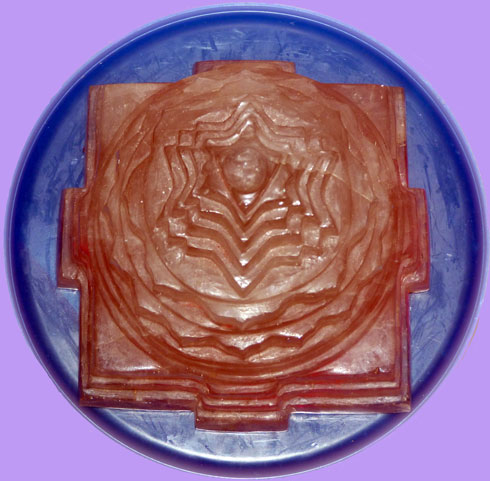 A Simple Puja for Maha Meru The Maha Meru requires no formal prayers or worship, nor must it be kept only in vegetarian homes – a reverential attitude toward it is enough. Its effects, for example, may be enhanced simply by playing soft music in its proximity. Those who know how to perform a proper Sri Chakra puja (formal devotional worship) using the Meru can accrue unlimited benefits – but this is a complicated and lengthy procedure, and not very easy to learn, requiring much time and effort. However, provided here is a simple puja designed for laypersons who are short on time but would still like to perform a more serious and formal worship of their Maha Meru: 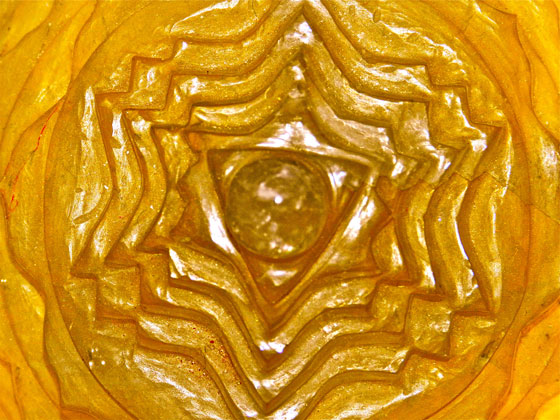 Abhishekam to the Eight Matrukas The Bhupura – the square, outermost enclosure of Sri Meru, as described above – is comprised of three walls which are, in turn, graced by the 28 Devis or yoginis known respectively as the Ten Mudra Shaktis, the Eight Matruka and the Ten Siddhis. In this puja we focus upon the Ashta Matruka, who govern the second or middle Bhupura wall, in each of its cardinal and intermediate directions; thus it is to the eight corners of the Sri Meru’s square enclosure that we shall direct our worship. The names and associations of the Devis residing at each location tell us how and why they are useful as intermediaries in helping us to obtain the grace of Para Shakti. 1 - Brahmi is Brahma’s Atma Shakti, Saraswati, who symbolizes creativity in all of its aspects, most prominently music and knowledge. In all efforts that improve one’s quality of life in this regard – for example, education, learning and creativity – worship of Brahmi is recommended. 2 - Maheshwari is the Goddess of Shiva; She brings Mahat Tattva (i.e., the first transformation of primordial nature, containing all other elements in their subtle, unmanifest forms) under control. So for those who aspire to greatness, through whatever means (for example, through business or enterprise in their various forms); for those who must insist on the right things being done at the right times by the right people; for those who require a bit of aggression to preserve their competitive edge – propitiation of Maheshwari is recommended. 3 - Kaumari is the Atma Shakti of Kumara or Skanda, Ganesha’s brother, whose wives are Valli and Devasena. He is Shanmukha, the Kundalini Shakti; the serpent power itself. He resides in all six chakras, balancing them; he is also the leader of the Devas’ armies. Worship of Kaumari is recommended for couples who wish to obtain Santana, or progeny. By propitiating Kaumari – through worship of the Yoni, which is the seat of Kundalini as Nagashakti – wellness hormones are generated, and conditions suitable for conception are created. 4 - Vaishnavi is the Atma Shakti of Vishnu, whose nature is Maya. Maya means Hreemkaara; it is involvement in the world. So Vaishnavi, a form of Lakshmi who creates these illusions of Samsara, can assist in improving one’s relationships in life – between husband and wife, between friends; in all kinds of interpersonal relationships. 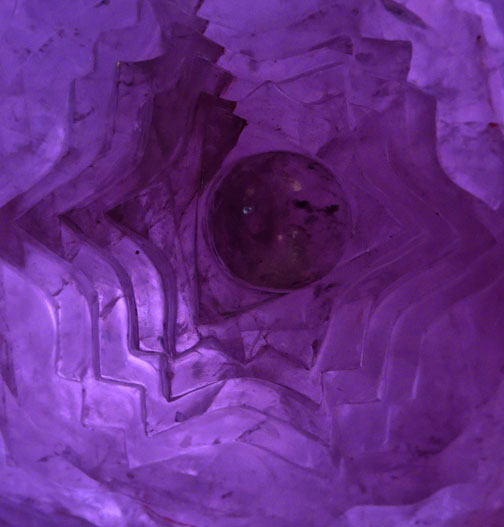 5 - Varahi is the commander-in-chief of the armed forces of Lalita Devi. Residing at the Ajna Chakra, She has vast armies at Her command (ajna), with which She can defeat any enemy. Positive use of Varahi’s powers enables us to treat various diseases and internal enemies, such as kama (lust), krodha (anger), lobha (delusion), moha (pride), mada (jealousy) and matsarya (envy), and bring them under control. Thus Varahi can be used for effectively controlling diseases and improving one’s quality of life. She can also be invoked to bring relief to others, by chanting sankalpam³ with their names and doing japa (mantra recitation) or prokshana (the actual or visualized sprinkling of energized water on the person on whose behalf you are appealing) with the Varahi Mantra. Varahi is especially useful in bringing relief to terminally ill patients, such as those suffering from cancer and AIDS. 6 - Mahendri is the Atma Shakti of Indra, the God of Rain. He sends his thunderbolt, Vajra, to seed the clouds and bring the rain that fertilizes the Earth. Thus all desires regarding the wellbeing of crops, control of floods and other such natural calamities; anything related to rain and water and fertilization of the earth – is best handled through the worship of Mahendri. She protects crops, ensures better dairy products and is generally useful for those in the agricultural industries, as well as for environmental control. 7 - Chamunda is the War Goddess, a form of Chandi; “Chamunda Shava Vahana” – She who lives in cemeteries, riding upon a revivified corpse. Propitiating Chamunda will enable you to absolutely control all evils done to you and to eliminate those evils. 8 - Mahalakshmi is the wealth of Sri Naraayana. She is Cosmic Awareness, and shuns pettiness in all its aspects. Thus She represents the infinite wealth of the Lord, and removes poverty of all kinds. The Ashta Aishwaryas and Ashta Lakshmis are all under Her control and they all obey Her commands. It is therefore appropriate to propitiate Her in order to get a feel for the spiritual wealth of the Lord. She not only bestows material benefits, but also grants the proper frame of mind for reaching the oceanic, infinite antaryami (One Residing Within) of Divine Consciousness. The simplest form of worship is abhishekam using Panchamrita – pour a spoonful of Panchamrita onto the Sri Meru location corresponding to each of these Devis as you recite their respective mantras, as given below. If you want a particular result, you can make a corresponding sankalpa³ and worship that Goddess by chanting Her mantra 108 times. These are just general hints for the people who don’t have much time to spare, but still wish to maximize the benefits of their Sri Meru, to help them light the path of their lives. May the Goddess bless all of you so. 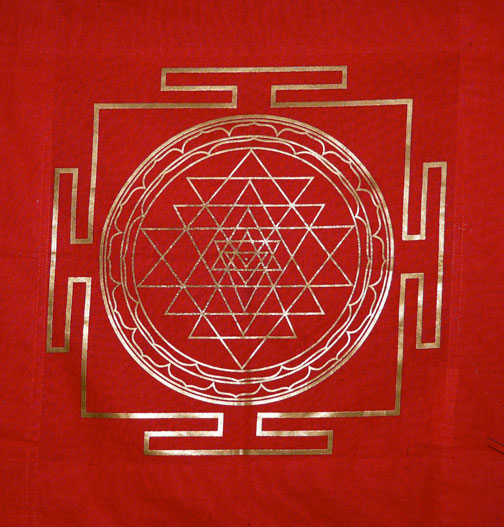 Shree Yantra placement The Surya (Sun) mark at one of the corner of the Meru should be towards your left when you install it. If you look at the tip , you would find only one of them which is exactly in line with the bottom base (other two are off centred) . This is the Face of the yantra and it should face East. You may place the Shreeyantra preferably near the West wall, so that the tip faces East. If not, then you may place on any wall except the East wall. It should be placed in such a location which is visible from all sides of your living room .. as it will affect all locations from where it is visible. The back of the yantra (exactly opposite the tip) does not show Aura, so you should not face it .. so it is best if this is against the wall. The yantra is placed at height above your Navel ( when standing) and below head.  1 - Abhishekam is the ritual bathing of a murthi (temple or shrine image), yantra, guru or other human recipient. 2 - Panchamrita generally refers to a ritual mixture used in Hindu worship services. As its name implies, it is made of five ingredients, usually milk, ghee, curd (yogurt), honey, and jaggery. Each of these ‘nectars’ has an origin in Hindu tradition. The milk is that of Kamadhenu (the divine wish-fulfilling cow); the curd represents the white, smooth and cool luster of the moon; the ghee is the food of the gods themselves, with a long Vedic past; honey, the extract of all herbs, is the essence of life with herbal healing powers; and jaggery, the extract of sugarcane, is both the representation and the epitome of sweetness.  * This excellent article is from the Rudra Center. Gayatri Rudra Center Home |
G